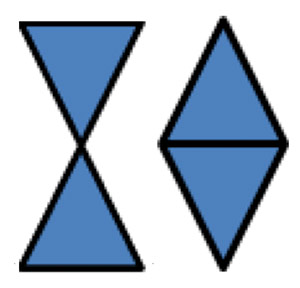
By Rebecca Soto, ABOC/NCLEC
Over the past five years of teaching, I have learned that prism often seems to be a bad word to many in our business. I am unsure why, but then again I love prism. Maybe I love it because I understand it. My goal as an educator is always to help others understand it, too.
When inspecting eyewear, we are either checking for a prescribed prism or unwanted prism due to error. A prescription will specify the amount of prism and the base direction of the prism. Prism directions consist of the base in, base out, base up or base down. All lenses are prisms. Prism is a transparent medium that deviates light. Prism does not focus. Prisms consist of an apex and a base. Plus lenses are base to base, where minus lenses are apex to apex. Prism can be either prescribed or unwanted.
Prism can be prescribed to correct diplopia, phoria and convergence. Patients who experience symptoms of double vision can be prescribed prism so that they see one image.
When looking through the optical center of a lens, no displacement of the image occurs. When a patient looks through an area other than the optical center of the lens, an object will be displaced toward the apex of the prism. The prismatic effect
a patient will experience when looking in an area other than the optical center depends on the distance from the area where the patient is looking and the optical center of the lens. The formula used to calculate the amount of prism is called Prentice’s Rule. The formula for Prentice Rule is Power X Decentration divided by 10.
| EXAMPLE: PATIENT RX | ||
| OD: +3.50 | OS: +2.50 | PD: 34/32 |
During final inspection, it is discovered that the optical centers of the lens are placed 63 mm apart at 31.5 and 31.5 mm. How much prism will this produce in the left and right lenses? Which direction is the base? Will the lenses meet the ANSI standard guideline for horizontal prism tolerances?
To calculate prism, apply Prentice’s Rule:
Power X Decentration divided by 10.
OD: 3.50 x 2.5/10 = 0.87∆ BI
OS: 2.50 X 0.5/10 = 0.12∆ BI
Total Prism: 0.99∆ BI
When final inspecting eyewear, the right lens exceeds the tolerance for horizontal prism of 0.67∆ total. The lens does not pass inspection and as an optician, you know that the right lens must be remade.
In summary:
Prism Facts
- Prism has a thickest edge (base) and a thinnest edge (apex).
- Prism will displace light rays toward its base.
- Prism will displace image toward its apex.
- Prism does not magnify or minify image.
- Prism has no focusing power.
- Prism Base Direction Notation: identified as base up, down, in, out (BU, BD, BI or BO)
- Amount of prismatic effect depends on the distance from the patient’s ocular center to the lens optical center.













